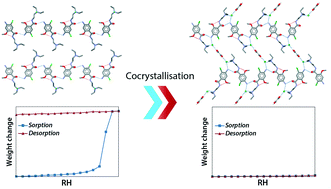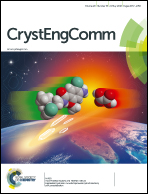Suppressed hydration in metoclopramide hydrochloride by salt cocrystallisation†
Abstract
Metoclopramide (MCP), a widely used antiemetic drug, is marketed as hydrochloride salt existing in the monohydrate and anhydrate forms. In this study, the hydration/dehydration behaviour of MCP hydrochloride salt was investigated by thermal and crystal structure analysis. Major structural rearrangement occurred upon dehydration, indicating the important role of water in stabilising the structure of the monohydrate form. Crystal structure analysis revealed that the lack of strong hydrogen bonds and less efficient packing in the anhydrate form contributed to the conversion to the monohydrate form in high humidity by increasing the solid state stability. To overcome hydrate/anhydrate conversion, a cocrystal of MCP hydrochloride with oxalic acid was synthesised, in which all hydrogen bond donor and acceptor sites of MCP were utilised with comparable packing efficiency to the monohydrate form. These features are responsible for the stability of the salt cocrystal against hydration. In addition, the salt cocrystal showed stability against dissociation in aqueous slurry experiments. This pharmaceutically acceptable salt cocrystal exhibits superior thermal and humidity stability and its slower dissolution rate is promising for extended release formulations. This study highlights the role of salt cocrystallisation in improving the physicochemical properties of active pharmaceutical ingredients in salt form.



 Please wait while we load your content...
Please wait while we load your content...